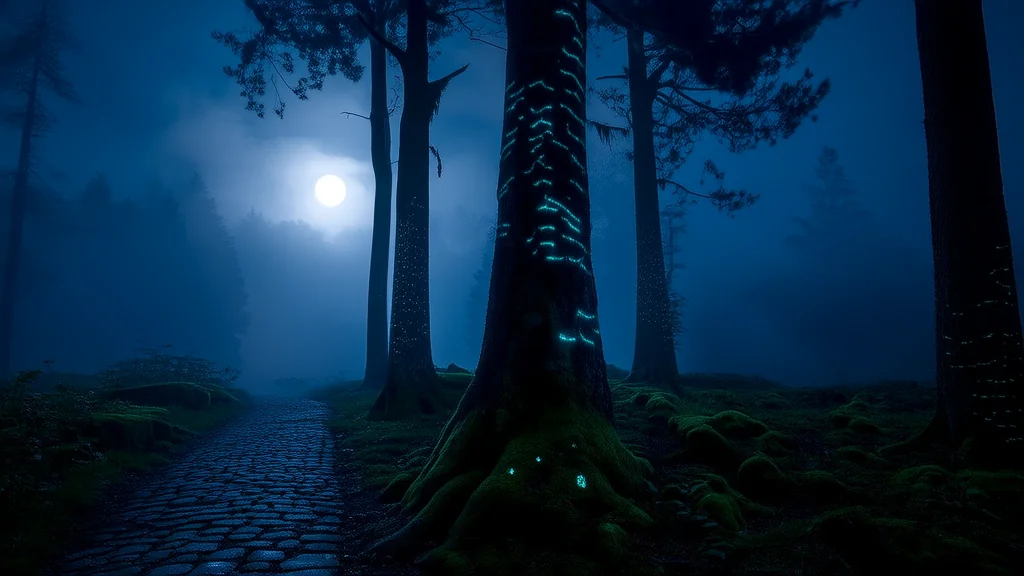🔮 Weird Tales & Urban Legends
The Whispering Symbols of Eldergrove and the Secret Beneath the Full Moon

The town of Eldergrove had always been quiet, a place where time seemed to move slower and the air carried the scent of old wood and damp earth. Most people didn’t mind the silence; it was comforting, like a lullaby sung by the wind. But for those who lived long enough, there were whispers—stories passed down in hushed tones about the symbols.
They appeared only when the moon was full, etched into the bark of the ancient oaks that lined the edge of the forest. No one knew how they got there, or who carved them, but they were always the same: a spiral surrounded by three crescent moons, and a single line that curled like smoke. The townsfolk avoided the trees, even though no one could explain why. Some said the symbols glowed faintly at night, others claimed they moved when you weren’t looking.
Lena had never believed in such things. She was a young woman with a camera and a curious mind, drawn to the untouched corners of the world. When she arrived in Eldergrove to photograph the old forest, she thought the stories were just local folklore. But as the days passed, she found herself returning to the trees, her fingers tracing the strange carvings, fascinated by their symmetry and depth.
One evening, as the sun dipped below the horizon, she noticed something different. The symbols had changed. The spiral was now broken, and the crescents had shifted positions. It wasn’t just a mistake in the carving—it felt deliberate. She took a photo, her breath catching as the image on her phone flickered, the symbols twisting slightly before settling back into place.
She began to research the symbols, pouring over dusty tomes in the town library. They were mentioned in an old journal from the 1800s, written by a man named Elias Thorn. He spoke of a forgotten ritual, a way to communicate with the unseen. The symbols, he wrote, were not meant to be seen by the living. They were warnings, or perhaps invitations. "Beware the path between," he had scrawled in the margin, his handwriting shaky and desperate.
That night, Lena dreamed of the forest. She walked through it, the trees towering like sentinels, their branches weaving a canopy that blocked out the sky. The symbols glowed beneath her feet, pulsing with a soft light. A voice whispered in her ear, not in words, but in feelings—loneliness, longing, and something else, something deeper. She woke with a start, her hands trembling.
The next morning, she returned to the trees. This time, the symbols were gone. In their place was a single word, carved into the bark in a language she didn’t recognize. It looked like a name, but it wasn’t one she knew. She tried to take a photo, but the camera wouldn’t focus. The image remained blurry, as if the word was trying to hide itself.
Days passed, and the more she searched, the more the symbols reappeared in places she hadn’t seen before. On the side of an abandoned barn, on the bottom of a well, even on the windowsill of her rented room. Each time, they were slightly different, as if they were learning, adapting. She began to feel watched, not by anything visible, but by the weight of unseen eyes.
One night, she followed the symbols deep into the forest. The path was clear, though no one had ever spoken of it. The trees grew taller, the air colder. She reached a clearing where a stone circle stood, its center marked by a deep, circular pit. The symbols were etched around the edges, glowing faintly. At the center, a single candle burned, its flame blue and unmoving.
As she stepped closer, the symbols on the ground began to shift, forming a pattern that matched the ones she had seen before. The candle’s light flickered, and for a moment, she saw a figure standing at the edge of the clearing. It wasn’t human, but it wasn’t entirely otherworldly either. It was something in between, a shape that changed as she tried to focus on it.
Then, the candle went out.
The symbols dimmed, and the forest fell silent. Lena ran, not knowing why, only that she had to leave before the darkness swallowed her whole. She didn’t look back.
When she returned to town, the symbols were gone. No one remembered seeing them, and the townspeople dismissed her story as the ramblings of a woman who had spent too much time alone. But Lena kept the photo, the one that showed the symbols shifting, the one that no one else could see.
And sometimes, in the stillness of the night, she wondered if the symbols had left her, or if they had simply waited for the right moment to return.
发布于 en
🔗
相关站点
- AI Blog — AI 趋势与技术新闻